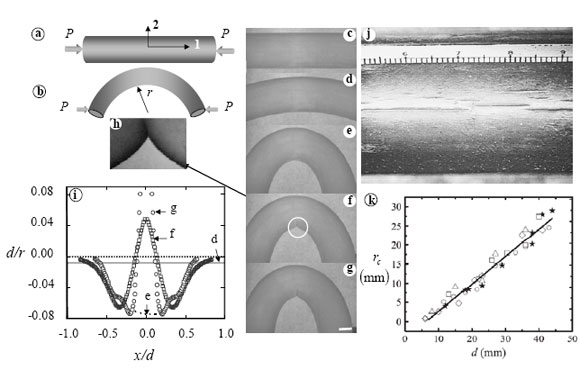| |
Stress induced surface instability of soft materials
We will now present few examples of surface instability which are caused by compressive stresses.

Figure 31.1
(a)-(b) Schematic of an experiment in which a straight gel cylinder of circular or rectangular cross section is subjected to compressive end loads leading to buckling. (c)–(g) A typical sequence of video micrographs show the progressive appearance of kink. Video micrograph
(h) depicts a magnified picture of the cylinder close to the kink.
(i) Dimensionless inner curvature of the cylinder plotted as a function of dimensionless length of cylinder.
(j) When a block of rubber is bent beyond a critical curvature wrinkles appear in the form of surface creases.
(k) The critical radius of curvature is plotted as a function of diameter of the gel cylinder. |
Kinking Instability
Figure 1 depicts the schematic of an experiment, in which a soft, elastic, solid cylinder of poly-acrylamide gel was compressed axially between two rigid supports. The cylinder, which was essentially a straight rod initially, buckled at a critical load forming a smooth curve at both its inner and outer sides, both of which could be perfectly described by a Jacobian elliptic function corroborating with the profile of a curved elastica. This phenomenon is the classical Euler’s buckling instability that we have dealt with to some detail.
However, as the cylinder was bent to an increasing extent by application of increased end load, while the outer side still followed the elliptic function, the inner side of it deviated from such a behaviour, and it deviated increasingly because of the effect of finite diameter of the cylinder. Eventually, closed to the location of maximum curvature of the cylinder, a sharp fold appeared in the form of a “kink” with a catastrophic change in curvature. Thus, beyond a critical bending the curvature got localized within a distance ~d from the location of the kink; once localized, the kink acted as a hinge, so that, with further bending, the curvature did not change significantly. Video images in Figs. 1(c)–(f) represent a typical sequence leading to the appearance of the kink for a cylinder of diameter  mm and shear modulus mm and shear modulus  kPa. These images were grabbed at temporal resolution of 25 fps. The trace of the inner curve of each image was analysed for obtaining the radius of curvature and importantly the critical radius of curvature at which the kink appeared. The image in figure 1(j) defines the inner side of a bent rubber block for which wrinkles appear at a critical load. kPa. These images were grabbed at temporal resolution of 25 fps. The trace of the inner curve of each image was analysed for obtaining the radius of curvature and importantly the critical radius of curvature at which the kink appeared. The image in figure 1(j) defines the inner side of a bent rubber block for which wrinkles appear at a critical load. |